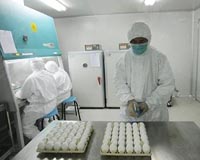| . |  |
. |
London, UK (SPX) Apr 01, 2010 Scientists are learning how our immune system senses and tracks down infection in the body by responding to chemical "scents" emitted by bacteria. Studying how immune cells manipulate their movement in response to external signals could shed light not only on how our immune system functions but also how cancer cells spread through the body and even how the brain wires itself. Speaking at the Society for General Microbiology's spring meeting in Edinburgh, Dr Holger Kress describes a new technique pioneered by himself and Professor Eric Dufresne at Yale University in the US that uses sponge-like micro-particles to mimic bacteria. The micro-particles slowly release a characteristic bacterial "scent" that is picked up by immune cells, causing them to actively move towards the source of the chemical in an attempt to hunt down the model microbes. These micro-particles can be trapped and manipulated three-dimensionally using 'optical tweezers' - highly focussed laser beams that are able to precisely control the movement of the particles to within a millionth of a millimetre. "By controlling the shape of the chemical signals, we were able to control the movements of immune cells and study how they respond to the signals," said Dr Kress. The scientists found that a single chemical-releasing micro-particle was enough to encourage neutrophils (a type of immune cell) to migrate towards it. Within less than one minute's exposure to the micro-particle, the neutrophils were able to polarize the growth of their internal 'skeleton' in the direction of the chemical. Dr Kress explained that although researchers had successfully identified the types of chemical signals that stimulate immune cells, it is still a challenge to work out the exact details of the immune cell response. "This new technique allows us to measure systematically how cells respond to various stimuli over minute gradients in time and space." Dr Kress believes his technique could be applied across a wide range of research fields. "Cell migration along chemical gradients of this kind plays a key role in wound healing and the wiring of the brain. It is also an essential feature of many diseases - particularly metastatic cancers," he said.
Share This Article With Planet Earth
Related Links Society for General Microbiology Epidemics on Earth - Bird Flu, HIV/AIDS, Ebola
 Bulgarian minister resigns over swine flu vaccines
Bulgarian minister resigns over swine flu vaccinesSofia (AFP) March 30, 2010 Bulgarian Health Minister Bojidar Nanev resigned Tuesday after he was charged with wasting public funds for allegedly purchasing swine flu vaccines at excessive prices. "The accusations are completely unfounded," Nanev said in a statement. "Nevertheless, I will tender my resignation." "It is out of the question that I remain in this post as long as there is the slightest doubt I mi ... read more |
|
| The content herein, unless otherwise known to be public domain, are Copyright 1995-2010 - SpaceDaily. AFP and UPI Wire Stories are copyright Agence France-Presse and United Press International. ESA Portal Reports are copyright European Space Agency. All NASA sourced material is public domain. Additional copyrights may apply in whole or part to other bona fide parties. Advertising does not imply endorsement,agreement or approval of any opinions, statements or information provided by SpaceDaily on any Web page published or hosted by SpaceDaily. Privacy Statement |